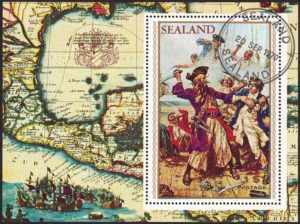
In 1718 our ancestor George Walker I was appointed to the office of Naval Officer of the Lower District of the James River. As such, Walker was involved in the campaign to capture or kill the famous pirate Edward Teach, known as Blackbeard the Pirate. That story follows, but first, as our present day politicians squabble over seemingly trivial matters, we can take some comfort from the fact that “it has always been thus.”
Lt. Gov. Spotswood Appoints George Walker, Battles the House of Burgesses
Lt. Gov. Alexander Spotswood was the chief executive of the colony of Virginia, from 1710 through 1722 (the nominal Governor Hamilton never left England). Spotswood is remembered for laying out much of the city plan of Williamsburg and building the Governor’s Palace and Bruton Parish Church. However, relations between the Lt. Gov. and the House of Burgesses were abysmal, to a humorous extent.
The Journal of the House of Burgesses survives. Here are a few entries:
- November 24, 1712 – The House refuses any more money for building the Bruton Church than the 200 pounds voted in 1710.
- November 27, 1715 – Gov. Spotswood charges that the House of Burgesses aspires to greater authority than was ever pretended by the House of Commons [in London].
- November 8, 1718 – Spotswood offers to bet the House of Burgesses 1,000 pounds that their charges against him would be decided unjust by any impartial person.
- November 21, 1718 – The Governor complained of for appointing George Walker, a known Quaker, to execute the office of a naval officer in the Lower District of James River.
George Walker I, the “known Quaker,” was our ancestor. Walker was a James River pilot and ship repairman who lived in an area called Kecoughtan, a few miles down-river from Williamsburg. He was also an artillery gunner at the nearby fort at Point Comfort, at the mouth of the James. Walker was a life-long Quaker—which was tolerated in Virginia for the most part, but evidently not by all. Read more about these religious differences in A Dispute over the Religious Education of the Children, and more about Quakerism in colonial Virginia in The Scottish Scholar and Missionary.
The Hunt For Blackbeard
There’s another fascinating entry in the Burgesses’ Journal from the same time:
- November 18, 1718 – Reward offered for the capture of Captain Edward Teach (Blackbeard) and his officers and crew.
Gov. Spotswood launched a campaign against Blackbeard in the summer of 1718, gradually collecting intelligence on Blackbeard’s whereabouts. On Nov. 17, 1718, two British ships departed from Kecoughtan and sailed to Ocracoke Island off North Carolina where, on November 22, they found Blackbeard and crew camped. During a ferocious battle, the notorious Blackbeard was killed.
George Walker And Blackbeard
We can be fairly certain that George Walker I was involved in the preparations for this expedition as Spotswood’s Naval Officer for the lower James, and because the British ships departed from Kecoughtan (where Walker lived and worked). In fact, just 4 months earlier, Spotswood had awarded Walker a deed for additional riverfront land for a new wharf in Kecoughtan, “gained by his industry.”
Might Walker have had earlier encounters with Blackbeard? Repaired ships damaged by Blackbeard’s pirates? Fired the Point Comfort artillery at Blackbeard’s fleet? It would be fun to know how often Blackbeard sailed into the Chesapeake Bay, whether he attacked and damaged ships based on the James, and whether he ever approached the fort at Point Comfort, a subject of future research.
© 2013 W. Mullins
